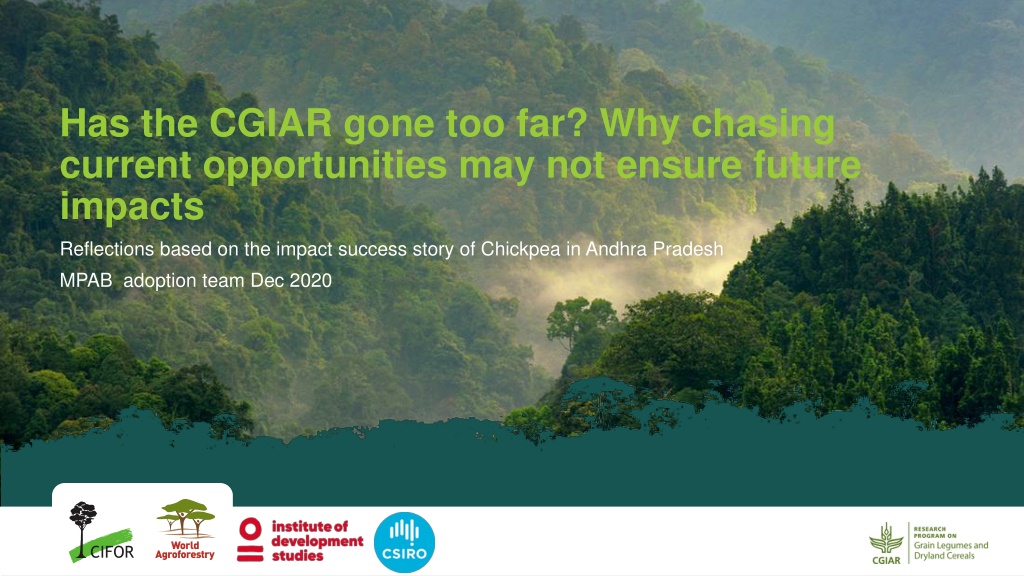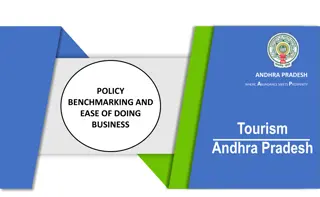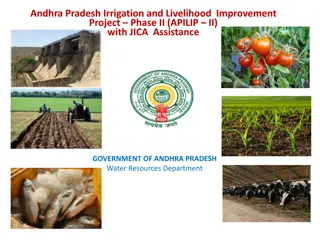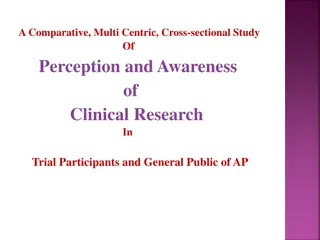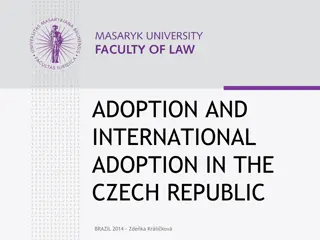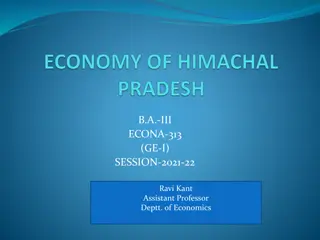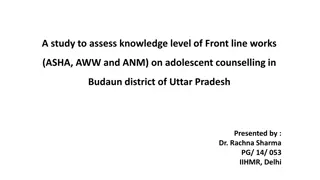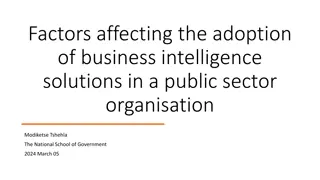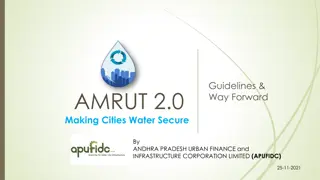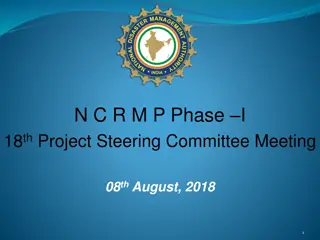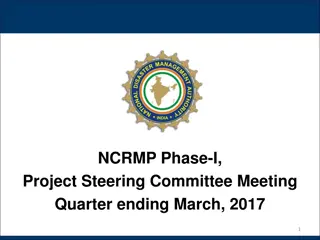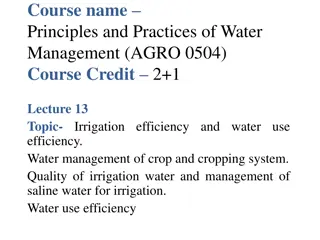Rethinking Impact Success: Lessons from Chickpea Adoption in Andhra Pradesh
Reflecting on the impact success story of chickpea adoption in Andhra Pradesh, this article challenges the traditional narrative by highlighting the role of unforeseen factors and long-term strategies. It explores the implications for scaling approaches, technology targeting, and breeding strategies to ensure future impacts in agricultural systems.
Download Presentation

Please find below an Image/Link to download the presentation.
The content on the website is provided AS IS for your information and personal use only. It may not be sold, licensed, or shared on other websites without obtaining consent from the author. Download presentation by click this link. If you encounter any issues during the download, it is possible that the publisher has removed the file from their server.
E N D
Presentation Transcript
Has the CGIAR gone too far? Why chasing current opportunities may not ensure future impacts Reflections based on the impact success story of Chickpea in Andhra Pradesh MPAB adoption team Dec 2020
Introduction/ overview Despite recent estimates of 10:1 return on investment in CGIAR technology impact pathways are highly diverse and the recipe for impact success remains elusive (Alston et al. 2020) We looked at the impact success stories of 90+% adoption of chickpea (CP) varieties in Andhra Pradesh (AP) and used a novel perspective to reconstruct and attribute how this success came about. The accepted narrative of this success is: A great variety was developed, it fitted farming system/ cropping patterns, collaboration with national RD and E organizing helped promote the variety, farmers highly appreciated the variety and helped spread it farmer to farmer. The accepted narrative is not wrong, But is only a partial explanation of of the factors that lead to this success.
A new narrative of success This was a success that that was 20 years in the making, underpinned by inspired/ lucky/ obvious breeding decision in the 1980 when CP was a very minor crop in AP. The decline of CP production in Northern India, strong market signals, decline of traditional AP crops like cotton, labour shortages etc, created an opportunity space that the new variety equipped farmers to respond to. This scenario that was critical to the spread of the technology but could not have been predicted, nor could it have been engineered. [a similar pattern was seen in Myanmar despite much weaker RD&E support in country) This finding is discussed in relation to: The implications for the appropriateness of scaling approaches, such as the scaling readiness framework. The implications for technology targeting (geographic/ agro-ecological/ agri-food system) The implications for breeding strategies and the balance between responding to current demands vs preparing for uncertain and unpredictable agri-food system futures.
The PEDR Framework - exploring farmers relationship with technical change PROPOSITIONS: any new technology is encountered or perceived for the first time as an idea or image of what could or might be. The proposition conjures up the possibility of an alternative way of working or making to achieve new or different outcomes ENCOUNTERS: Members of a farming community become aware of a new proposition through an encounter. The encounter is the occasion or arena where this awareness occurs DISPOSITIONS:The people on the receiving end of propositions are agents within encounters, who may be disposed to respond in a variety of ways. Dispositions are combinations of cultural, economic, biophysical, spatial, temporal and other factors shape perceptions of a proposition. They generate a spectrum of different dispositions among different people/households that encounter the proposition and determine whether, and in what ways, a proposition is perceived as a relevant and interesting opportunity for each individual decision maker. RESPONSES: People who are positively disposed to a proposition, and respond to it, embark on a process, and create a discrete pathway, through which the three components of the proposition artefacts, methods and modes of engagement in farming are unpacked, reassembled and configured.
Chickpea in Andhra Pradesh: a slow start In the 1970s and 1980s, there was no new chickpea technology proposition on offer in AP. Growers planted traditional, low-yielding, long-season varieties that were susceptible to diseases. Chickpea was widely grown in northern states, while the major crops in AP included cotton, tobacco and chilli. Still, ICRISAT decided to develop improved varieties with the following characteristics: i) early-maturing ii) drought-tolerant iii) disease-resistant with a higher yield potential overall. Decline in chickpea cultivation in northern India (expansion of irrigation and high-input agriculture) In AP: failure of cotton, chilli and tobaccocrops leads to farmers' distress and farmers suicides Governmental measures to discourage tobacco cultivation [1990 s] Farmers in urgent need of alternatives change in the OPPORTUNITY LANDSCAPE CHANGES and switching to chickpea cultivation could have started to emerge as a PROPOSITION Yet, in 1993, only the Swetha (ICCV2) variety was available potential encounters with chickpea cultivation would have been few in number and poor in quality. This led to slow uptake, low levels of awareness about the variety and low levels of supply and limited availability
which ended with a success The early 2000s development of JG11 and other new cultivars, a proposition which finally offered a distinct advantage: early maturation - drought tolerance - disease resistance). Production and distribution scaled up rapidly & were promoted through subsidy and by public seed and extension systems At the same time, the opportunity landscape was continuing to change, with the implementation of the MGNREGS labour costs for farm operators, and the development and commercialisation of machinery that could be used to mechanise cultivation of chickpeas. increased Favourable combination of factors: Chickpea had a variety of RESPONSES observable to others in the landscape (including farmers who switched from cotton into rotations of soybean or sesame with chickpea; or switched from sesame and safflower to chickpeas; or progressively used chickpeas as an entry into dairy production.) Farmers positively DISPOSED towards it easily managed and cheap- to-cultivate post-monsoon crop that could be grown with a subsidy, stable market demand and good output prices. ENCOUNTERED through formal and informal channels that included information, extension, and input supply. Feasible PROPOSITION as farmers are looking for alternative crops
Scaling: technology or context? Exposing farmers to the new technology was important, but its rapid spread was not driven by the quality of extension (there were other informal encounters) but by the way the opportunity landscape disposed farmers to the new technology allowing them to respond to the opportunity. A good technology in the right setting only needs a nudge rather than a heavy push Scaling readiness frameworks (Schut et al) suggest a delivery pipeline where, once a technology is perfected, it can be rolled out by choosing appropriate delivery partners Emphasis on the quality and readiness of the technology diverts attention from the readiness of the farming system in a particular context. Such frameworks may work where the need for technology is predictable/generic (e.g. replacing one maize variety with a slightly better one with the same characteristics), but less useful where where needs are uncertain and unpredictable and subject to dynamics in the agri-food system as a whole. The replicable part of the AP CP impact process is not the story of the insertion of a particular variety and its spread. Rather the replicable part of the process is having a long-term breeding strategy that offers a range of options that represent no regrets anticipations of future demand
Agri-food system: dynamics and uncertainty Uptake and spread of new varieties are ultimately dependent on the way farmers interact with the technology and their behavior and decision making. However, their decision making is conditioned by a set of factors not only at the farm and farming system scale, but at the scale of the whole agri-food system and the dynamics and uncertainty that these system display - technical changes in North Indian agriculture interacted with markets and consumer demand to create an opportunity, other agri-food system forces playing out in AP (cotton, labour etc) made this opportunity attractive. New technologies can not only be targeted at appropriate agro-ecological zone, but also at appropriate opportunity spaces that are characterized by market, institutional and other social and economic features. Searching for emerging opportunities within these agri-food system dynamics, and supporting pathways that allow technical and other forms of response that support farmers to gain advantage of these dynamics could accelerate impact performance. Needs to be underpinned by a menu of robust technology options.
What did we learn? The key is responding to context and then getting the dissemination (P E D R) right Breeding is longer term process that has to take bets for future states Product profiles attempt to anticipate these future states and respond Yet any predictions for the future are made under uncertainty If the likely scenarios do not materialize products will not match Changes that lead to new windows of opportunity emerging won t be served through this approach and opportunities can not be seized
What did we learn? A broader set of basic material should be built likely through core like support A more targeted set of likely products can be developed using the currently applied market facing breeding and dissemination approach Diversity will be key to remain relevant and hedge bets on future states continuous context scanning and adjustments for future scenarios required
Has the CGIAR gone too far towards servicing todays demands Breeding has gone through a number of phases with respect to demand orientation and accountability The early years (70s+80s): Science led breeding let a thousand flowers bloom. Long term risky science inquiries The dawn of impact scrutiny (1990) A mixed model of long term risky science enquiries, increasingly tempered by loss of core funding, short term projects and growing impact scrutiny Today CRP phase (2010-oneCGIAR): Breeding for specific market demands (product profiles and private sector business models) the Gates model Questions? Did we move too far from long term risky research with uncertain impacts towards a private sector model? Was the success of the 90s build upon having the right mix of approaches (and funding) to facilitate more agile responses to emerging opportunities and being prepared for the unexpected How do we get the right mix of breeding in the blue and aligning to likely (and less likely) future states of the world (market, climate, )? Could this also be the key to serve a greater diversity of heterogenous farming settings and aspirations? If the CGIAR becomes more like the private sector, who does the risky research that the poor need when unpredictable events disrupt the farming systems they rely on?
Questions to be answered for the post-CRP programming Did we move too far from long term risky research with uncertain impacts towards a private sector model? Was the success of the 90s build upon having the right mix of approaches (and funding) to facilitate more agile responses to emerging opportunities and being prepared for the unexpected How do we get the right mix of breeding in the blue and aligning to likely (and less likely) future states of the world (market, climate, )? Could this also be the key to serve a greater diversity of heterogenous farming settings and aspirations? If the CGIAR becomes more like the private sector, who does the risky research that the poor need when unpredictable events disrupt the farming systems they rely on?
Where do we go from here? Some ideas about what we do next????????? Thinking about and testing new accountability frameworks towards donors that could enable them to restart core funding lines Impact assessments at the CGIAR levels to highlight overall success rather than single projects fitting for science rather than development efforts
